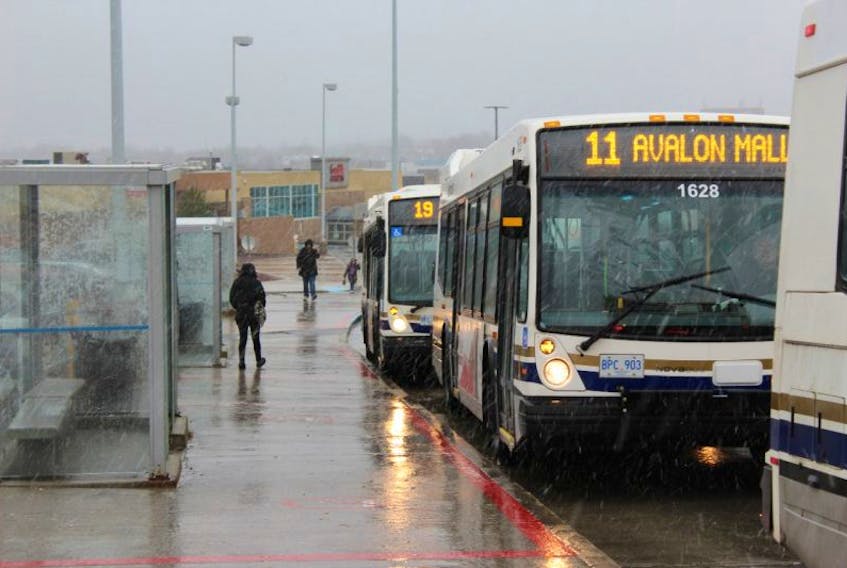Meades is also the provincial co-ordinator for the Transition House Association of Newfoundland and Labrador and said the planned fare hike in 2017 — 25 cents a ride, $8 on a monthly pass and $30 for a four-month semester — would be fine, if low-income earners were not forced to pay.
“Almost every major city in Canada has a low-income transit pass option, which means that if you’re living below certain income, normally the poverty line, you get a 50 per cent subsidy,” he said. “Some cities you get 100 per cent subsidy, but you get a minimum of 50 per cent subsidy on your transit rates, which means that if you’re poor, you only pay half the rate for the bus. That’s as opposed to what’s happening now, which is they have to pay full fare and that fare is increasing.”
On Thursday, according to a Toronto Star report, the City of Toronto’s mayor’s executive committee approved plans for the introduction of a “Fair Pass Program.” Eligible residents are expected to see a 33 per cent discount for a single adult fare and 21 per cent off an adult monthly pass, according to the report, to be phased in starting in 2018.
The same as in St. John’s, the Toronto Transit Commission (TTC) already pays to offer discounted fares to children, seniors and students. However, the new low-income pass is also being put to Toronto city council for approval.
Some other cities do have low-income fares in place, including but not limited to: Calgary, Edmonton, Regina, Kingston and Halifax. Halifax Regional Municipality is actually on a six-month pilot program. Its “low income transit pass” offers a 50 per cent discount on the basic monthly pass. It was issued to 500 applicants whose gross household income amounted to $33,000 or less.
A report to follow the pilot will help to determine if the new pass continues to be offered.
The City of St. John’s noted its planned Metrobus fee increases in a Nov. 23 press release, along with planned increases to other fees, from the cost of public pool rentals to on-street parking permits.
“These revised fees, which have been considered together with our estimated overall program review savings, enhances our ability to meet expenditure needs for 2017 and to consider a mil rate reduction for the upcoming budget year,” said Coun. Jonathan Galgay, in the release.
Galgay was not available for an interview Friday, but a statement provided in response to questions noted the new Metrobus fares will be the average for cities of roughly the same size in other parts of Canada, and that bus transit rates were held steady from 2008 to 2016, even as the cost of providing the service increased. “On average, transit systems in Canada serving similar populations (from 50,001 to 150,000) are between 50 to 60 per cent subsidized,” the response stated. “As of 2017 the subsidy from the City of St. John’s will be above national average, at 63.8 per cent subsidized.”
Even so, Meades said, the new fare is not necessarily a fair fare for low-income earners.
He sent a letter to the council and told The Telegram he has spoken with individual councilors, including Galgay, but expects the rate hikes will go through as announced.
“I am ashamed of my city for making this decision, ashamed that I voted for individuals who would consider raising tax revenue off the backs of people living in poverty. I would be very unlikely to vote for anyone again that felt this was an acceptable course of action,” he stated in his letter to council.
The city’s next budget, following a series of staff cuts as well as the announced fee increases, is set to be released Dec. 12.
Meades is also the provincial co-ordinator for the Transition House Association of Newfoundland and Labrador and said the planned fare hike in 2017 — 25 cents a ride, $8 on a monthly pass and $30 for a four-month semester — would be fine, if low-income earners were not forced to pay.
“Almost every major city in Canada has a low-income transit pass option, which means that if you’re living below certain income, normally the poverty line, you get a 50 per cent subsidy,” he said. “Some cities you get 100 per cent subsidy, but you get a minimum of 50 per cent subsidy on your transit rates, which means that if you’re poor, you only pay half the rate for the bus. That’s as opposed to what’s happening now, which is they have to pay full fare and that fare is increasing.”
On Thursday, according to a Toronto Star report, the City of Toronto’s mayor’s executive committee approved plans for the introduction of a “Fair Pass Program.” Eligible residents are expected to see a 33 per cent discount for a single adult fare and 21 per cent off an adult monthly pass, according to the report, to be phased in starting in 2018.
The same as in St. John’s, the Toronto Transit Commission (TTC) already pays to offer discounted fares to children, seniors and students. However, the new low-income pass is also being put to Toronto city council for approval.
Some other cities do have low-income fares in place, including but not limited to: Calgary, Edmonton, Regina, Kingston and Halifax. Halifax Regional Municipality is actually on a six-month pilot program. Its “low income transit pass” offers a 50 per cent discount on the basic monthly pass. It was issued to 500 applicants whose gross household income amounted to $33,000 or less.
A report to follow the pilot will help to determine if the new pass continues to be offered.
The City of St. John’s noted its planned Metrobus fee increases in a Nov. 23 press release, along with planned increases to other fees, from the cost of public pool rentals to on-street parking permits.
“These revised fees, which have been considered together with our estimated overall program review savings, enhances our ability to meet expenditure needs for 2017 and to consider a mil rate reduction for the upcoming budget year,” said Coun. Jonathan Galgay, in the release.
Galgay was not available for an interview Friday, but a statement provided in response to questions noted the new Metrobus fares will be the average for cities of roughly the same size in other parts of Canada, and that bus transit rates were held steady from 2008 to 2016, even as the cost of providing the service increased. “On average, transit systems in Canada serving similar populations (from 50,001 to 150,000) are between 50 to 60 per cent subsidized,” the response stated. “As of 2017 the subsidy from the City of St. John’s will be above national average, at 63.8 per cent subsidized.”
Even so, Meades said, the new fare is not necessarily a fair fare for low-income earners.
He sent a letter to the council and told The Telegram he has spoken with individual councilors, including Galgay, but expects the rate hikes will go through as announced.
“I am ashamed of my city for making this decision, ashamed that I voted for individuals who would consider raising tax revenue off the backs of people living in poverty. I would be very unlikely to vote for anyone again that felt this was an acceptable course of action,” he stated in his letter to council.
The city’s next budget, following a series of staff cuts as well as the announced fee increases, is set to be released Dec. 12.









